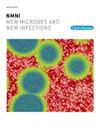炎症性肠病患者和健康人优势肠道菌群的比较分析:一项病例对照研究
IF 5.4
Q2 INFECTIOUS DISEASES
引用次数: 0
摘要
背景:肠道慢性炎症可能与微生物群失调有关。目的本研究旨在探讨成年IBD患者与健康对照组相比肠道菌群组成的变化。方法采用病例对照研究,探讨成人肠道菌群组成与IBD的关系。利用细菌16S rRNA基因进行实时定量pcr分析,对30例IBD患者(克罗恩病13例,溃疡性结肠炎17例)和30例健康对照的粪便样本中6个关键菌群(厚壁菌门、乳杆菌、双歧杆菌、梭杆菌、脆弱拟杆菌和prausnitzfaecalibacterium)的丰度进行了定量分析。采用相关矩阵来评估这些细菌之间的关系。结果实时荧光定量pcr结果显示,IBD患者与健康对照组的细菌群丰度存在显著差异(p值<;0.05)。与对照组相比,IBD患者中厚壁菌门、梭杆菌和脆弱杆菌的丰度显著增加(p值<;0.05)。相反,在IBD患者中,乳酸菌和prausnitzii的丰度均显著降低(p值<;0.05)。虽然一些细菌群在CD或UC患者中表现出更高的丰度趋势,但这些差异没有统计学意义(p值>;0.111)。相关矩阵分析揭示了特定的共现模式:拟杆菌与普雷沃氏菌呈强负相关,在健康对照中更为丰富,表明IBD患者的优势发生了转变。乳酸菌和prausnitzii在健康个体中表现出正相关,表明它们在维持肠道内稳态方面具有潜在的协同作用。本研究发现,与健康对照组相比,成年IBD患者肠道菌群组成发生了显著变化,在特定细菌群的丰度上存在显著差异。这些发现表明肠道菌群失调可能在IBD发病机制中起关键作用。特定细菌失衡的识别为开发基于微生物群的治疗提供了基础,如益生菌、益生元和粪便微生物群移植,作为恢复微生物平衡和缓解疾病进展的潜在干预措施。需要进一步的研究将这些见解转化为有针对性的治疗策略,并探索其在临床环境中的有效性。本文章由计算机程序翻译,如有差异,请以英文原文为准。
Comparative analysis of dominant gut microbiota in Inflammatory Bowel Disease patients and healthy individuals: A case-control study
Background
Chronic inflammation in the gut might be linked to microbiota dysbiosis.
Objective
This study aimed to investigate alterations in the gut microbiota composition of adult IBD patients compared to healthy controls.
Methods
This case-control study investigated the relationship between faecal microbiota composition and IBD in adults. Real-time qPCR analysis using bacterial 16S rRNA gene quantified the abundance of six key bacterial groups (Firmicutes, Lactobacillus spp., Bifidobacterium spp., Fusobacterium spp., Bacteroides fragilis, and Faecalibacterium prausnitzii) in faecal samples from 30 IBD patients (13 Crohn's disease, 17 ulcerative colitis) and 30 healthy controls. A correlation matrix was employed to assess relationships between these bacteria.
Results
Real-time qPCR revealed significant differences (p-value <0.05) in the abundance of several bacterial groups between IBD patients and healthy controls. Firmicutes, Fusobacterium spp., and B. fragilis were significantly more abundant (p-value <0.05) in IBD patients compared to controls. Conversely, Lactobacillus spp. and F. prausnitzii were both significantly less abundant (p-value <0.05) in IBD patients. While some bacterial groups exhibited trends toward higher abundance in either CD or UC patients, these differences were not statistically significant (p-value >0.111). The correlation matrix analysis revealed specific co-occurrence patterns: Bacteroides showed a strong negative correlation with Prevotella, more abundant in healthy controls, suggesting a shift in dominance in IBD patients. Lactobacillus spp. and F. prausnitzii exhibited a positive correlation in healthy individuals, indicating their potential cooperative role in maintaining gut homeostasis.
Conclusion
This study identified significant alterations in gut microbiota composition in adult IBD patients compared to healthy controls, with notable differences in the abundance of specific bacterial groups. These findings suggest that gut microbiota dysbiosis may play a critical role in IBD pathogenesis. The identification of specific bacterial imbalances provides a foundation for developing microbiota-based therapies, such as probiotics, prebiotics, and fecal microbiota transplantation, as potential interventions for restoring microbial balance and mitigating disease progression. Further research is needed to translate these insights into targeted therapeutic strategies and to explore their effectiveness in clinical settings.
求助全文
通过发布文献求助,成功后即可免费获取论文全文。
去求助
来源期刊

New Microbes and New Infections
Medicine-Infectious Diseases
CiteScore
10.00
自引率
2.50%
发文量
91
审稿时长
114 days
 求助内容:
求助内容: 应助结果提醒方式:
应助结果提醒方式:


